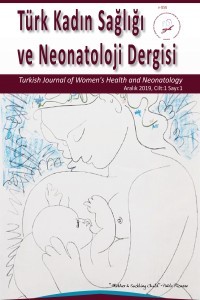Müjde Can İBANOĞLU, Ayse Gulcin BASTEMUR, Harun KARAAĞAÇ, Ertan AKPINAR, Aslıhan KARA, Ayşe ÖZCAN, Ömer Lütfi TAPISIZ, Yaprak USTUN
Postpartum septik olgu: COVID-19 ve ürosepsisin ayırıcı tanısı
İlk olarak Çin'in Wuhan kentinde tanımlanan yeni tip koronavirüs hastalığı (COVID-19), küresel bir halk sağlığı sorunu olan, bir çeşit solunum yolu enfeksiyonudur. Vaka raporları ve küçük kohort çalışmalarından oluşan, gebelikte COVID-19 ile ilgili veriler sınırlıdır. Doğum sonrası ürosepsis de küresel olarak yaygın bir hastalıktır ve pekçok yayın bulunmaktadır. Sepsis bulguları olan postpartum hastalar, salgın sırasında; halk sağlığı ve hastanın kendi iyiliği açısından COVID-19 için test edilmelidir. Ürosepsisin klinik özellikleri, doğum sonrası hastalarda COVID-19 hastalığına benzer olabilir. Bu olgu sunumu ile; postpartum dönemde ani akut solunum bozukluğu ve septik şok bulguları geliştiren bir vakada COVID-19 enfeksiyonu ve ürosepsis ayırıcı tanısının ve tedavisinin nasıl yönetildiğini anlatmak amaçlanmıştır.
Anahtar Kelimeler:
postpartum ürosepsis, Şiddetli akut respiratuvar sendrom, koronavirus, pandemi, postpartum ürosepsis, pnömoni, gebelik
A postpartum septic case: Differential diagnosis of COVID-19 infection and urosepsis.
First identified in Wuhan of China, the novel coronavirus disease 2019 (COVID-19) is a respiratory tract infection with a global public health emergency. Data regarding COVID-19 in pregnancy is limited, consisting of case reports and small cohort studies. Postpartum urosepsis is also a globally common disease and well documented. Postpartum patients with sepsis findings should be tested for COVID-19 during outbreak for public health and patients’ well-being. The clinical characteristics of urosepsis might be similar to COVID-19 disease in postpartum patients. Here, we reported the clinical management of a case with acute respiratory disorder and septic shock due to urosepsis in the postpartum period, mimicking COVID-19 infection.
Keywords:
Severe acute respiratory syndrome, coronavirus, pandemic, postpartum urosepsis, pneumonia, pregnancy,
___
- Maharaj D. Puerperal pyrexia: a review. Part I. Obstetrical & gynecological survey. 2007; 62:393-399.
- Bone RC, Balk RA, Cerra FB, Dellinger RP, Fein AM, Knaus WA, et al. Definitions for sepsis and organ failure and guidelines for the use of innovative therapies in sepsis. Chest 1992; 101:1644-1655.
- Bone RC, Sprung CL, Sibbald WJ. Definitions for sepsis and organ failure. Crit Care Med 1992; 20:724-726.
- Dhama K, Khan S, Tiwari R, et al. Coronavirus Disease 2019-COVID-19. Clin Microbiol Rev 2020; 33:e00028-20.
- Covid TC, Team R. Severe Outcomes Among Patients with Coronavirus Disease 2019 (COVID-19)-United States, February 12-March 16, 2020. MMWR Morb Mortal Wkly Rep. 2020; 69:343-346.
- Organization WH. Laboratory testing for coronavirus disease 2019 (COVID-19) in suspected human cases: interim guidance, 2 March 2020. World Health Organization, 2020.
- Huang C, Wang Y, Li X, et al. Clinical features of patients infected with 2019 novel coronavirus in Wuhan, China. Lancet. 2020; 395:497-506.
- Chen N, Zhou M, Dong X, et al. Epidemiological and clinical characteristics of 99 cases of 2019 novel coronavirus pneumonia in Wuhan, China: a descriptive study. Lancet 2020; 395:507-13.
- Mullins E, Evans D, Viner RM, O'Brien P, Morris E. Coronavirus in pregnancy and delivery: rapid review. Ultrasound Obstet Gynecol 2020; 55:586-592.
- De Rose DU, Piersigilli F, Ronchetti MP, et al. Novel Coronavirus disease (COVID-19) in newborns and infants: what we know so far. Ital J Pediatr 2020; 46:56.
- van Dillen J, Zwart J, Schutte J, van Roosmalen J. Maternal sepsis: epidemiology, etiology and outcome. Current Opinion Inf Dis 2010; 23:249-254.
- Knowles S, O'sullivan N, Meenan A, Hanniffy R, Robson M. Maternal sepsis incidence, aetiology and outcome for mother and fetus: a prospective study. BJOG 2015; 122:663-671.
- Bamfo JE. Managing the risks of sepsis in pregnancy. Best Pract Res Clin Obstet Gynaecol 2013; 27:583-595.
- Başlangıç: 2019
- Yayıncı: Sağlık Bilimleri Üniversitesi Etlik Zübeyde Hanım Kadın Hastalıkları Eğitim ve Araştırma Hastanesi
Sayıdaki Diğer Makaleler
İstemi Han ÇELİK, Zehra ARSLAN, Sezin UNAL, Leyla MOLLAMAHMUTOĞLU, Ahmet Yağmur BAŞ, Nihal DEMİREL
Postpartum septik olgu: COVID-19 ve ürosepsisin ayırıcı tanısı
Müjde Can İBANOĞLU, Ayse Gulcin BASTEMUR, Harun KARAAĞAÇ, Ertan AKPINAR, Aslıhan KARA, Ayşe ÖZCAN, Ömer Lütfi TAPISIZ, Yaprak USTUN
Hulusi ZEYNELOGLU, Yusuf Aytaç TOHMA, Göğşen ÖNALAN, Emre GÜNAKAN
Doğum öncesi bakımda Down Sendromlu fetüsün teşhisi nasıl olmalıdır?
